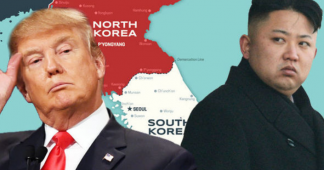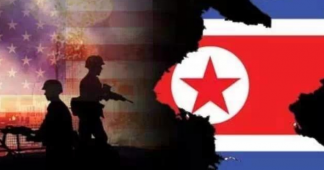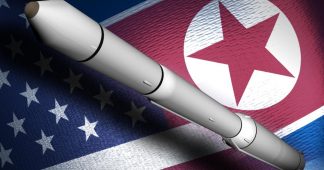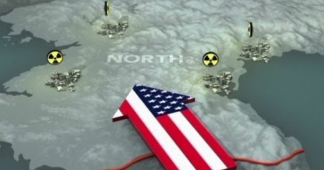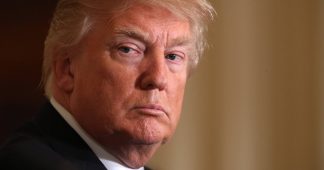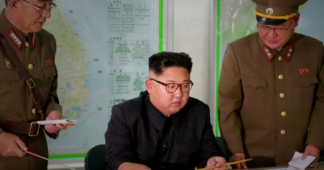By Peter Symonds
The Trump administration has pulled back, temporarily at least, from the brink of war with North Korea, after North Korean leader Kim Jong-un reportedly put on hold plans to test fire four missiles into waters just short of Guam. The American territory, home to the Andersen Air Force Base and Naval Base Guam, would be centrally involved in any war on North Korea.
Kim warned of the missile test following Trump’s unprecedented threat last week to engulf North Korea in “fire and fury like the world has never seen”—that is, in nuclear war. On Tuesday, having reviewed the military plans, Kim declared he would wait “a little more” and watch “the foolish and stupid conduct of the Yankees.”
In a tweet yesterday, Trump appeared to dial back his inflammatory rhetoric, declaring: “Kim Jong-un of North Korea made a very wise and well reasoned decision. The alternative would have been both catastrophic and unacceptable!”
The situation on the Korean Peninsula remains on a hair trigger, however. A mistake or miscalculation could set off a chain of events that could plunge the region and the world into a devastating war.
Next Monday, the US and South Korean militaries are due to begin large-scale war games that North Korea has bitterly opposed as a direct military threat. The annual exercises, known as Ulchi-Freedom Guardian, will last for 10 days and centre on computer simulations, as a rehearsal for war with North Korea.
The military drills, which inevitably will raise tensions with Pyongyang, also involve substantial numbers of troops. “The August exercises typically involve around 30,000 American soldiers and about 56,000 South Korean troops,” the New York Times reported. “The numbers swell to a total of about 530,000 because government officials and civilians also take part in some of the exercises.”
The Ulchi-Freedom Guardian drills are only one aspect of the ongoing US military preparations for war with North Korea. Yesterday, in another show of force, two US B-1 strategic bombers, operating with Japanese fighter jets, conducted exercises to the southwest of the Korean Peninsula.
Washington’s confrontation with Pyongyang also has raised tensions with China and Russia, which fear the eruption of war on their borders with North Korea. In a phone call on Tuesday, Chinese Foreign Minister Wang Yi told his Russian counterpart Sergey Lavrov their governments should “not permit anyone to provoke incidents at the doorsteps of China and Russia.”
America’s top military officer, General Joe Dunford, was in China this week for high-level talks with Chinese military commanders after visiting South Korea. Dunford, the Pentagon’s Joint Chiefs of Staff chairman, signed an agreement with his Chinese counterpart, General Fang Fenghui, on Tuesday to improve communication and dialogue between the two militaries in a bid to reduce the risk of miscalculation.
There was no hiding the differences, however, including over North Korea. China has repeatedly called on both the US and North Korea to ease tensions and lay the basis for talks by suspending joint US-South Korean exercises in return for a halt on North Korean missile and nuclear tests.
On Tuesday, US State Department spokeswoman Heather Nauert again ruled out any halt to US war games with South Korea, declaring there was “no moral equivalency” with the North Korean tests and therefore there would be no change to the Pentagon’s plans.
According to a US military spokesman, Dunford stressed that “the US views with growing urgency the need for China to increase pressure on the North Korean regime.” Beijing, however, has already voted for harsh sanctions on North Korea in the UN Security Council and began their implementation this week with bans on the import of North Korean coal, iron ore, iron, lead and seafood.
China reluctantly agreed to the new sanctions in the hope that would ease tensions and open the door for negotiations. Instead last week, Trump ratcheted up the confrontation with North Korea, declaring on Friday that the “military options” were “locked and loaded.” On Monday, Trump further poisoned relations with Beijing by initiating an investigation into China’s alleged “theft” of US intellectual property that could result in US trade penalties.
Dunford yesterday visited the headquarters of the Chinese military’s Northern Theatre Command, which covers China’s border with North Korea. In talks with Dunford, its commander Song Puxuan said the North Korean nuclear issue must be resolved diplomatically through talks.
The Trump administration is facing opposition from South Korean President Moon Jae-in. On Tuesday, Moon bluntly opposed any country taking military action without his government’s approval. “It’s only South Korea that can decide on a military action on the Korean Peninsula,” he said in a nationally televised speech.
While in South Korea, Dunford said the US military’s priority was to support a solution through diplomatic and economic pressure. But he also declared that “we are preparing a military option in case such efforts fail.”
Moon’s remarks, made on National Independence Day to mark the end of Japanese colonial rule, were clearly aimed at the South Korean public. Any attempt to oppose the use of bases in South Korea in a US war on North Korea would rapidly precipitate a political crisis in Seoul because the country’s military is closely tied to Washington. In the event of war with North Korea, the US automatically assumes control of the South Korean military.
In Chile yesterday, US Vice President Mike Pence made clear the threat of war against North Korea continued, saying that “all options” remained on the table. He urged Latin American countries to further isolate Pyongyang by cutting all diplomatic and commercial ties.
Whatever the immediate outcome of the current US standoff with North Korea, Trump’s reckless threat of nuclear war has fundamentally altered the strategic and military calculations of allies and rivals alike as each is forced to consider how to respond. As a result, the world has been brought one step closer to a global conflagration.
